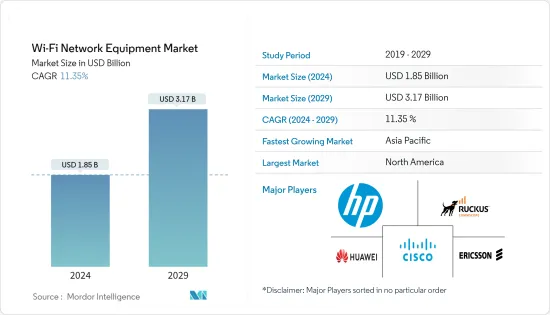
|
시장보고서
상품코드
1549923
Wi-Fi 네트워크 장비 - 시장 점유율 분석, 산업 동향 및 통계, 성장 예측(2024-2029년)Wi-Fi Network Equipment - Market Share Analysis, Industry Trends & Statistics, Growth Forecasts (2024 - 2029) |
||||||
세계 Wi-Fi 네트워크 장비 시장 규모는 2024년 18억 5,000만 달러로 추정되며, 2029년에는 31억 7,000만 달러에 달할 것으로 예상되며, 예측 기간(2024-2029년) 동안 CAGR 11.35%로 성장할 것으로 예상됩니다.

주요 하이라이트
- 소비자, 상업 및 산업 환경에서 사물인터넷(IoT) 기기의 사용 증가는 기기 수요를 촉진하는 주요 요인이며, 5G 기술의 부상으로 기업들은 더 많은 커넥티드 기기를 수용하고 비즈니스 데이터 활용 능력을 강화할 준비가 되어 있습니다. 이러한 스마트 기기 및 커넥티드 기기의 도입 급증은 세계 Wi-Fi 네트워크 장비 시장의 성장을 직접적으로 견인할 것입니다.
- 또한 많은 기업들이 보안을 강화하고 데이터 교환을 간소화하기 위해 네트워크 장비를 점검하고 있습니다. 최신 Wi-Fi 표준인 Wi-Fi 6 및 Wi-Fi 6E 연결의 채택은 여러 장치를 동시에 처리할 때 속도, 용량 및 효율성을 향상시킬 수 있습니다. 이러한 발전은 화상 회의, 게임, IoT 기기 등 대역폭을 많이 사용하는 애플리케이션을 지원하는 데 매우 중요하며, World in Data에 따르면 2023년에는 전체 인구의 63%만이 온라인 인터넷에 접속할 수 있었습니다.
- 2023년 사무실 복귀 명령이 주도권을 잡았지만, 유연성을 요구하는 목소리가 여전히 강합니다. 많은 기업들이 사무실 복귀를 기업 문화 강화에 필수적인 요소로 여기고 있지만, 사무실 복귀에는 큰 장애물이 있습니다. 협업은 대면 회의, 가상 통화, 첨단 기술 등 전통적인 사무실 환경을 제공하지만, 대면 회의, 가상 통화, 첨단 기술 등 전통적인 사무실 환경도 제공합니다. 따라서 이러한 수요를 충족시키기 위한 가정용 와이파이 기기에 대한 수요는 여전히 증가하고 있습니다.
- Wi-Fi 네트워크는 주로 Wi-Fi 지원 기기의 보급으로 인해 수많은 보안 위협에 직면하고 있습니다. 보안 프로토콜의 기술적 발전에도 불구하고, 데이터의 안전과 무결성을 유지하는 것은 여전히 중요한 과제입니다. 특히 기업에서 민감한 정보를 다루는 경우, 데이터 유출의 위험은 더욱 커집니다. 공격자들은 이러한 취약점을 악용하여 데이터에 대한 무단 액세스를 유발하는 경우가 많습니다.
- COVID-19 사태 이후 기업 및 서비스 제공업체들은 원격 사용자의 증가된 트래픽에 대응하기 위해 네트워크 인프라 업그레이드에 많은 투자를 했습니다. 기존 Wi-Fi 네트워크를 업그레이드하고 새로운 기술을 도입하여 안전하고 안정적인 연결성을 확보하기 위한 계획을 세웠습니다.
Wi-Fi 네트워크 장비 시장 동향
기업용 부문이 큰 비중을 차지할 것으로 예상
- 기업은 조직, 교육, 의료 및 대규모 비즈니스 통신에 필수적인 인프라와 서비스를 제공하는 매우 중요한 부문을 형성하고 있습니다. 기업은 음성, 데이터, 인터넷 서비스를 지원하는 네트워크 인프라의 구축과 유지보수를 감독합니다.
- 경찰, 소방, 구급 등 공공안전 기관은 신속한 정보 공유, 조정 및 긴급 대응을 위해 이러한 Wi-Fi 네트워크 장비에 크게 의존하고 있습니다. 또한 의료 분야는 안전한 환자 데이터 전송, 원격의료, 원격 모니터링 및 전문가 간의 원활한 의료 데이터 교환을 위해 이러한 네트워크에 의존하고 있습니다.
- 또한, Wi-Fi 6(802.11ax)에 대한 수요가 증가하고 있으며, 그 배경에는 고밀도 환경에서의 고속화 및 성능 향상이 있습니다. 많은 기업들이 대역폭을 필요로 하는 애플리케이션에 대한 수요 증가에 대응하기 위해 Wi-Fi 6로 업그레이드하고 있습니다. 많은 기업들이 중앙 집중식 관리, 확장성, 쉬운 배포가 가능한 클라우드 관리형 Wi-Fi 솔루션으로 전환하고 있습니다.
- AI 플랫폼과 애플리케이션은 기업 개발자에게 권한을 부여하고 ML의 능력을 활용하여 정확도를 높이고 사용자 경험을 개선하고 효율성을 높일 수 있으며, AI의 활용 범위는 엣지에서 코어, 클라우드로 확장될 것입니다. 예를 들어, 2023년 12월 Origin AI와 에어티즈는 와이파이 센싱 기술을 통해 ISP의 수익과 고객 만족도를 향상시키기 위해 제휴를 맺었습니다. 이 제휴는 스마트 와이파이 솔루션의 큰 진전을 의미합니다. 이번 제휴를 통해 에어티즈의 ISP 고객들은 광대역 서비스에 고급 침입 탐지 기능을 포함시켰으며, Origin의 첨단 기술을 통합함으로써 ISP의 수익원을 강화할 뿐만 아니라 고객 이탈을 방지하고 NPS(Net Promoter Score)를 향상시키는 것을 목표로 하고 있습니다.
- 또한 증가하는 사이버 보안 위협은 기업이 데이터를 보호하고 국가별 규정을 준수하기 위해 더 나은 보안 기능을 갖춘 고급 Wi-Fi 솔루션을 사용하도록 촉구하고 있으며, IBM의 데이터에 따르면, 2023년에는 제조업이 25.7%, 금융 및 보험업이 18.2%로 가장 큰 사이버 위협에 노출되어 있다고 합니다.
아시아태평양이 큰 성장 점유율을 차지할 것으로 예상
- 5G와 Wi-Fi는 종종 상호 보완적인 기술로 간주되며, 5G는 주로 광범위한 네트워크 커버리지와 고속 모바일 연결을 제공하는 반면, Wi-Fi는 대용량 및 국소 커버리지(특히 실내)를 제공합니다. 아시아태평양에서는 일부 선진 시장들이 5G 구축에 앞장서고 있습니다. 한국은 2019년 4월 세계 최초로 5G 전국망을 구축해 세계 최초로 5G 전국망을 구축했습니다. 같은 해 말 호주, 필리핀, 중국, 뉴질랜드에서 비슷한 구축이 빠르게 이어졌으며, GSMA Intelligence에 따르면 아시아태평양은 현재 5G 구축의 두 번째 물결이 일어나고 있으며, 인도네시아, 인도, 말레이시아 등 국가들은 2025년까지 5G를 세계 최대 규모로 구축할 것으로 예상됩니다. 아시아태평양을 세계 최대 5G 시장으로 끌어올릴 준비를 하고 있습니다.
- 도시 지역, 대중교통, 행사장 등에서 안정적인 인터넷 접속을 제공하기 위해 공공 와이파이 인프라 확충을 위한 투자가 확대되고 있습니다. 이러한 추세는 모든 사람의 연결성을 향상시키기 위한 정부의 노력과 민간 투자에 의해 뒷받침되고 있습니다. 시스코에 따르면, 아시아태평양이 전 세계 공공 와이파이 핫스팟 점유율이 가장 높으며, 2024년에는 약 48%를 넘어설 것으로 예상하고 있습니다.
- AI와 머신러닝은 네트워크 관리와 자동화를 점점 더 많이 형성하고 있습니다. 이러한 기술은 네트워크 설정을 자동화하고, 문제 해결을 간소화하며, 사용 패턴에 따라 성능을 향상시키고, AI는 네트워크 인프라의 에너지 소비를 최적화하는 데 매우 중요한 역할을 하며, 특히 첨단 통신 네트워크에서 탄소 배출량과 운영 비용을 크게 절감할 수 있습니다. CompTIA IT Industry Outlook 2024의 조사에 따르면, 채널 기업의 30%가 이미 AI를 업무에 적용하고 있으며, 26%는 AI 솔루션을 적극적으로 고려하고 있는 것으로 나타났습니다.
- 고해상도 비디오, 소프트웨어 업데이트, 데이터 세트와 같은 디지털 파일이 계속 증가함에 따라 고속, 광대역 네트워크는 매우 중요합니다. 더 빠른 전송 속도를 실현하여 사용자가 온라인에서 파일을 빠르게 다운로드하고 업로드할 수 있도록 합니다. 현재 많은 기업들이 데이터 보호를 강화하기 위해 클라우드 데이터베이스로 전환하고 있습니다. 이러한 상황에서 대역폭을 확장한 Wi-Fi는 온라인 데이터에 대한 빠르고 효율적인 액세스를 촉진하는 중요한 플레이어로 부상하고 있습니다.
- 특히 소비자 클라우드 스토리지가 확산되고 대용량 멀티미디어 파일을 로컬 하드 디스크 드라이브에서 전송하는 것만큼 빠르게 다운로드할 수 있게 되면서, 광대역 속도는 필수적인 요소가 되었습니다. 예를 들어, 시스코의 보고서에 따르면, 아시아태평양에서는 25Mbps 이상의 속도가 97%라는 놀라운 보급률을 보이고 있습니다.
- 일부 시장 기업들은 증강현실(AR) 사용 사례를 위한 고급 솔루션을 지원하기 위해 Wi-Fi 기술을 강화하고 있으며, 2024년 2월 화웨이는 최신 Wi-Fi 표준을 준수하는 최첨단 솔루션인 엔터프라이즈급 'AirEngine Wi-Fi 7'을 발표하며 선도적인 역할을 하고 있습니다. 이 기술은 특히 고밀도, 고 대역폭, 저지연 연결이 필요한 시나리오에서 더욱 강력하고 원활한 무선 네트워크를 약속합니다. 이러한 시나리오에는 메타버스(Metaverse) 접속, 교육용 증강현실/가상현실(AR/VR) 활용 등이 포함됩니다.
Wi-Fi 네트워크 장비 산업 개요
Wi-Fi 네트워크 장비 시장은 세분화되어 있으며, 다양한 업체들이 존재하고 있습니다. 이 시장에서 많은 벤더들이 제휴, 파트너십, 신규 출시 등 다양한 성장 전략에 집중하고 있습니다. 주목할 만한 기업으로는 Cisco Systems Inc., Hewlett Packard Enterprise Development LP (Aruba), CommScope (RUCKUS Networks), Telefonaktiebolaget LM Ericsson, Huawei Technologies Co. Ltd. 등이 있습니다.
- 2024년 1월, 네트워크 연결 분야에서 유명한 CommScope는 Wi-Fi Alliance가 자사의 RUCKUS Wi-Fi 7 AP 제품군을 엄격한 테스트 대상으로 선정했다고 밝혔습니다. 이번 선정으로 RUCKUS 장치는 인증 테스트베드에서 유일한 상용 액세스 포인트가 되어 Wi-Fi CERTIFIED 7 장치와의 원활한 상호 운용성을 보장합니다. 이는 차세대 디바이스의 세계 네트워크를 위한 Wi-Fi 성능 향상에 대한 CommScope의 노력을 강조하는 것입니다.
- 2023년 11월, 화웨이는 화웨이 커넥트 2023(Huawei Connect 2023)에서 모든 시나리오 WLAN 솔루션을 발표했습니다. 이 발표는 엔터프라이즈 분야에서의 Wi-Fi 7 기술 채택에 더욱 집중하여 교육, 의료, 소매, 제조 등 다양한 산업에서 고객의 네트워크 경험을 향상시켰으며, Wi-Fi 7의 향상된 대역폭 기능을 도입하여 캠퍼스 네트워크가 트래픽 증가에 대응하기 위해 멀티-Ge 캠퍼스로의 진화를 위한 준비를 하고 있습니다.
기타 혜택:
- 엑셀 형식의 시장 예측(ME) 시트
- 3개월간의 애널리스트 지원
목차
제1장 소개
- 조사 가정과 시장 정의
- 조사 범위
제2장 조사 방법
제3장 주요 요약
제4장 시장 인사이트
- 시장 개요
- 거시경제 시나리오 분석(경기후퇴, 러시아·우크라이나 위기 등)
- 인터넷 서비스 관련 규제 상황
- 각국의 데이터 보호 가이드라인에 관한 보도
제5장 시장 역학
- 시장 성장 촉진요인
- 커넥티드 디바이스 이용 확대와 BYOD 정책
- 기업의 디지털 전환 상승
- Wi-Fi 기술의 지속적인 기술 진보(Wi-Fi 6 규격 구현 등)
- 시장 성장 억제요인
- 데이터 보안과 프라이버시에 관한 우려
- 야외에서의 Wi-Fi 도입에 관한 우려
- Wi-Fi 접속 규격에 관한 인사이트
- 802.11b, 802.11a, 802.11g, 802.11n, 802.11ac, 802.11ax를 커버
- 사례 연구 분석
- 게스트 기업용 Wi-Fi 서비스의 도입 동향 개요
- 성장 촉진요인(고객 참여와 로열티에 대한 요구 상승|기업의 BYOD 동향|신뢰성 높은 Wi-Fi 액세스에 의한 기업 자산 사이버 보안 대책 강화의 필요성)
- 기업 Wi-Fi 핫스팟 관리 솔루션 개요와 주요 기능(분석을 포함)
- 업계별 사용 사례
- 여행·호스피탈리티, IT·통신, 소매·E-Commerce, 교육, BFSI 등을 커버
- 주요 벤더와 그 제품 개요
- Purple WiFi, Noniussoft, AVSystem, Wanaport 등을 커버
제6장 시장 세분화
- 기기 유형별
- 액세스 포인트
- 게이트웨이
- 라우터와 익스텐더
- 기타(케이블, 인터페이스, 모듈 등)
- 최종사용자별
- 소비자
- 기업
- 지역별
- 북미
- 미국
- 캐나다
- 유럽
- 영국
- 독일
- 프랑스
- 아시아태평양
- 중국
- 인도
- 일본
- 호주·뉴질랜드
- 중동 및 아프리카
- 사우디아라비아
- 아랍에미리트
- 남아프리카공화국
- 라틴아메리카
- 브라질
- 멕시코
- 북미
제7장 경쟁 상황
- 기업 개요
- Cisco Systems Inc.
- Hewlett Packard Enterprise Development LP(Aruba)
- CommScope(RUCKUS Networks)
- Telefonaktiebolaget LM Ericsson
- Huawei Technologies Co. Ltd
- Extreme Networks
- Ubiquiti Inc.
- D-Link Corporation
- TP-Link Corporation
- NETGEAR Inc.
제8장 시장 기회와 향후 동향
ksm 24.09.26The Wi-Fi Network Equipment Market size is estimated at USD 1.85 billion in 2024, and is expected to reach USD 3.17 billion by 2029, growing at a CAGR of 11.35% during the forecast period (2024-2029).

Key Highlights
- The increasing use of Internet of Things (IoT) devices in consumer, commercial, and industrial settings is a key driver for equipment demand. With the rise of 5G technology, organizations are poised to embrace even more connected devices, enhancing their ability to leverage business data. This surge in smart and connected device adoption directly fuels the global Wi-Fi network devices market's growth.
- Furthermore, many enterprises are overhauling their network equipment to bolster security and streamline data exchanges. The adoption of the latest Wi-Fi standards, Wi-Fi 6 and Wi-Fi 6E connectivity, facilitates improved speed, capacity, and efficiency in handling multiple devices simultaneously. These advancements are crucial for supporting bandwidth-intensive applications such as video conferencing, gaming, and IoT devices. As per the 'World in Data,' only 63% of the population had access to the online internet in 2023, which provides immense growth potential.
- While return-to-office mandates gained traction in 2023, the call for flexibility remains strong. Many firms view office returns as pivotal for bolstering their culture, yet the shift back poses significant hurdles. Collaboration provides traditional office setups, including in-person meetings, virtual calls, and advanced technology. Thus, there is still growth in the requirement for home Wi-Fi devices to cater to the demand.
- Wi-Fi networks encounter a myriad of security threats, primarily stemming from the prevalence of Wi-Fi-enabled devices. Despite technological advancements in security protocols, maintaining data safety and integrity remains a significant challenge. Particularly in corporate settings, when handling sensitive information, the risk of data breaches increases. Attackers exploit these vulnerabilities, often resulting in unauthorized data access.
- After the COVID-19 pandemic, enterprise and service providers invested heavily in upgrading the network infrastructure to cater to the increasing load that is coming from the remote user. The company planned for upgrading the existing Wi-Fi networks and implementing new technologies to ensure secure and reliable connectivity.
Wi-Fi Network Equipment Market Trends
The Enterprises Segment is Expected to Hold a Major Share
- Enterprises form a pivotal segment, offering the infrastructure and services crucial for organizational, educational, healthcare, and large-scale business communication. They oversee the deployment and maintenance of network infrastructures, supporting voice, data, and internet services.
- Public safety entities, including police, fire, and emergency services, heavily depend on these Wi-Fi network equipment devices for swift information sharing, coordination, and emergency response. Moreover, the healthcare sector relies on these networks for secure patient data transmission, telemedicine, remote monitoring, and seamless medical data exchange among professionals.
- Moreover, there is a growing need for Wi-Fi 6 (802.11 ax) adoption, which is driven by higher speed and better performance in dense environments. Many enterprises are upgrading to Wi-Fi 6, which caters to the increasing need for bandwidth-intensive applications. Many enterprises are moving toward cloud-managed Wi-Fi solutions, which allow centralized management, scalability, and easier deployment.
- AI platforms and applications empower enterprise developers, enabling them to harness ML's capabilities for heightened accuracy, user experience, and efficiency. The reach of AI is set to span from the edge to the core to the cloud. For instance, in December 2023, Origin AI and Airties joined forces to enhance ISP revenue and customer satisfaction through Wi-Fi Sensing Technology. This collaboration marks a significant advancement in Smart Wi-Fi solutions. By leveraging the partnership, Airties' ISP clients included an advanced intrusion detection feature in their broadband offerings. By integrating Origin's advanced technology, Airties aims to not only boost ISPs' revenue streams but also combat customer churn and elevate their Net Promoter Scores (NPS).
- Moreover, increasing cybersecurity threats encourage enterprises to use advanced Wi-Fi solutions with better security features to protect data and remain compliant with country-specific regulations. As per data by IBM, the manufacturing sector was exposed to maximum cyber threats, which were 25.7%, followed by the finance and insurance sector, with 18.2% threats in 2023.
Asia-Pacific is Expected to Hold a Major Growth Share
- 5G and Wi-Fi are often seen as complementary technologies. While 5G primarily provides broad network coverage and high-speed mobile connectivity, Wi-Fi offers high-capacity and localized coverage, especially indoors. Several advanced markets have taken the lead in rolling out 5G in Asia-Pacific. South Korea set the global pace by launching the world's first nationwide 5G network in April 2019. This was swiftly followed by similar deployments in Australia, the Philippines, China, and New Zealand later that same year. According to GSMA Intelligence, the region is now witnessing a second wave of 5G rollouts, with countries like Indonesia, India, and Malaysia poised to propel Asia-Pacific into one of the world's largest 5G markets by 2025.
- There is growing investment in expanding public Wi-Fi infrastructure to provide reliable internet access in urban areas, public transportation, and venues. This trend is supported by government initiatives and private-sector investments that aim to improve connectivity for all. According to Cisco, Asia-Pacific is expected to have the highest share of global public Wi-Fi hotspots, at around more than 48% in 2024.
- AI and machine learning are increasingly shaping network management and automation. These technologies automate network settings, streamline issue resolution, and enhance performance based on usage patterns. AI plays a pivotal role in optimizing energy consumption within network infrastructures, leading to substantial reductions in both carbon footprints and operational costs, especially in advanced telecommunications networks. According to the CompTIA IT Industry Outlook 2024 survey, 30% of channel firms are already integrating AI into their operations, while an additional 26% are actively exploring AI solutions.
- As digital files, including high-definition videos, software updates, and datasets, continue growing, networks with high speeds and greater bandwidth are crucial. They enable faster transfer rates and empower users to download and upload files swiftly online. Many corporations are now gravitating toward cloud databases for enhanced data protection. In this landscape, Wi-Fi with expanded bandwidth emerges as a key player, facilitating swift and efficient access to online data.
- High-bandwidth speeds are becoming imperative, especially as consumer cloud storage gains traction, ensuring that downloading large multimedia files is as swift as transferring them from a local hard drive. For example, a Cisco report highlights that Asia-Pacific has achieved a remarkable 97% penetration rate in delivering speeds exceeding 25 Mbps.
- Several market players are enhancing Wi-Fi technologies to cater to advanced solutions for augmented reality use cases. In February 2024, Huawei set the tone by introducing its enterprise-grade "AirEngine Wi-Fi 7," a cutting-edge solution that adheres to the latest Wi-Fi standards. This technology promises a more robust and seamless wireless network, especially in scenarios demanding high-density, high-bandwidth, and low-latency connections. These scenarios include accessing the metaverse and leveraging augmented reality/virtual reality (AR/VR) for educational purposes.
Wi-Fi Network Equipment Industry Overview
The Wi-Fi network equipment market is fragmented, with various significant players. In the market, numerous vendors are focused toward diverse growth strategies such as collaborations, partnerships, and new launches. Notable players include Cisco Systems Inc., Hewlett Packard Enterprise Development LP (Aruba), CommScope (RUCKUS Networks), Telefonaktiebolaget LM Ericsson, and Huawei Technologies Co. Ltd.
- In January 2024, CommScope, a prominent player in network connectivity, revealed that the Wi-Fi Alliance had chosen a member of its RUCKUS Wi-Fi 7 AP family for rigorous testing. This selection places the RUCKUS device as the sole commercial access point in the certification test bed, ensuring seamless interoperability with Wi-Fi CERTIFIED 7 devices. This move underscores CommScope's commitment to advancing Wi-Fi performance for the global network of next-gen devices.
- In November 2023, At Huawei Connect 2023, Huawei unveiled its All-Scenario WLAN Solution. This launch further focused on the adoption of Wi-Fi 7 technology in the enterprise sector, enhancing network experiences for customers across industries like education, healthcare, retail, and manufacturing. With the deployment of Wi-Fi 7's enhanced bandwidth capabilities, campus networks are gearing up for a multi-Ge campus evolution to handle the increased traffic.
Additional Benefits:
- The market estimate (ME) sheet in Excel format
- 3 months of analyst support
TABLE OF CONTENTS
1 INTRODUCTION
- 1.1 Study Assumptions and Market Definition
- 1.2 Scope of the Study
2 RESEARCH METHODOLOGY
3 EXECUTIVE SUMMARY
4 MARKET INSIGHTS
- 4.1 Market Overview
- 4.2 Analysis of Macro-Economic Scenarios (Recession, Russia-Ukraine crisis, etc.)
- 4.3 Regulatory Landscape Related to Internet Services
- 4.3.1 Coverage on Data protection Guidelines in Various Countries
5 MARKET DYNAMICS
- 5.1 Market Drivers
- 5.1.1 Growth in the use of connected devices and BYOD policy
- 5.1.2 Rising Digital Transformation in the Enterprises
- 5.1.3 Ongoing Technological Advancements in Wi-Fi Technology (Wi-Fi 6 Standard Implementation, etc.)
- 5.2 Market Restraints
- 5.2.1 Data securities and Privacy Concerns
- 5.2.2 Concerns Related to Wi-Fi Implementation in Outdoor Areas
- 5.3 Insights on Wi-Fi connectivity standards
- 5.3.1 Coverage on 802.11b, 802.11a, 802.11g, 802.11n, 802.11ac, and 802.11ax
- 5.4 Case Study Analysis
- 5.5 Overview of Adoption Trends of Guest Enterprise Wi-Fi Offerings
- 5.5.1 Growth Drivers (Increasing Need for Customer Engagement and Loyalty| Growing Trends of BYOD in Enterprises | Need for Enhanced Cyber Security Measures for Enterprises Assets with Reliable Wi-Fi Access)
- 5.5.2 Overview of Enterprise Wi-Fi Hotspot Management Solution and Key Features (Including Analytics)
- 5.5.3 Industry-wise use cases
- 5.5.3.1 Coverage on Travel and Hospitality, IT and telecom, Retail and E-commerce, Education, BFSI, etc.
- 5.5.4 Brief About Major Vendors and Their Offerings
- 5.5.4.1 Coverage on Purple WiFi, Noniussoft, AVSystem, Wanaport, etc.
6 MARKET SEGMENTATION
- 6.1 By Equipment Type
- 6.1.1 Access Points
- 6.1.2 Gateways
- 6.1.3 Routers and Extenders
- 6.1.4 Others (Cables, Interface, Modules, etc.)
- 6.2 By End User
- 6.2.1 Consumers
- 6.2.2 Enterprises
- 6.3 By Geography
- 6.3.1 North America
- 6.3.1.1 United States
- 6.3.1.2 Canada
- 6.3.2 Europe
- 6.3.2.1 United Kingdom
- 6.3.2.2 Germany
- 6.3.2.3 France
- 6.3.3 Asia-Pacific
- 6.3.3.1 China
- 6.3.3.2 India
- 6.3.3.3 Japan
- 6.3.4 Australia and New Zealand
- 6.3.5 Middle East and Africa
- 6.3.5.1 Saudi Arabia
- 6.3.5.2 United Arab Emirates
- 6.3.5.3 South Africa
- 6.3.6 Latin America
- 6.3.6.1 Brazil
- 6.3.6.2 Mexico
- 6.3.1 North America
7 COMPETITIVE LANDSCAPE
- 7.1 Company Profiles
- 7.1.1 Cisco Systems Inc.
- 7.1.2 Hewlett Packard Enterprise Development LP (Aruba)
- 7.1.3 CommScope (RUCKUS Networks)
- 7.1.4 Telefonaktiebolaget LM Ericsson
- 7.1.5 Huawei Technologies Co. Ltd
- 7.1.6 Extreme Networks
- 7.1.7 Ubiquiti Inc.
- 7.1.8 D-Link Corporation
- 7.1.9 TP-Link Corporation
- 7.1.10 NETGEAR Inc.



















